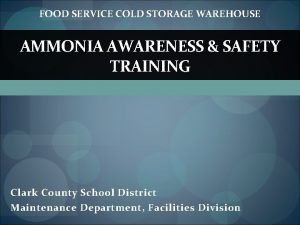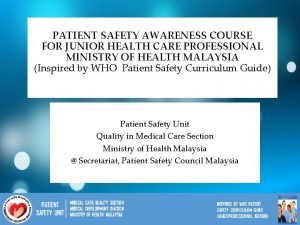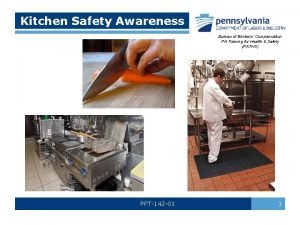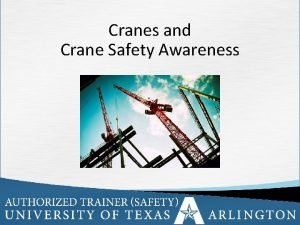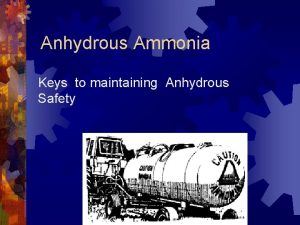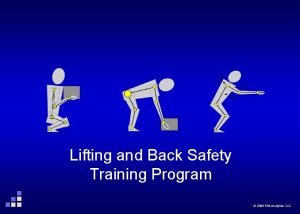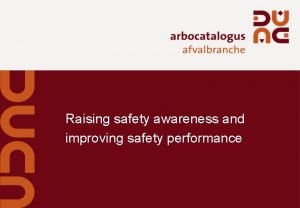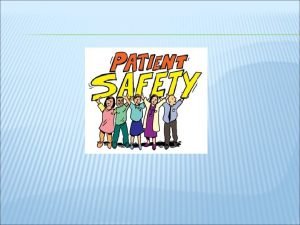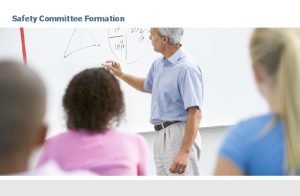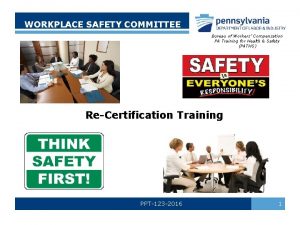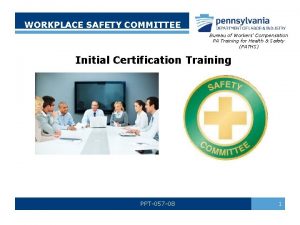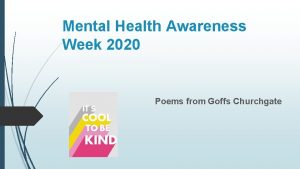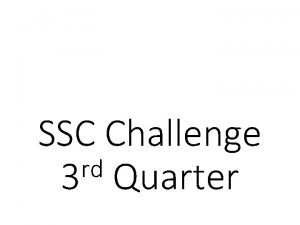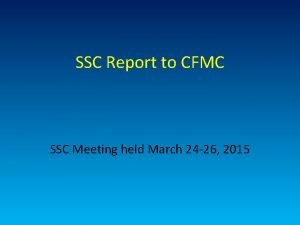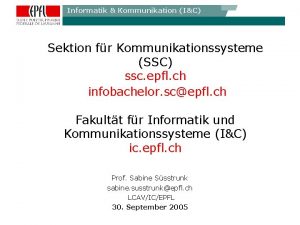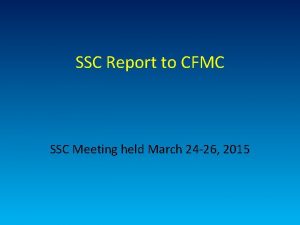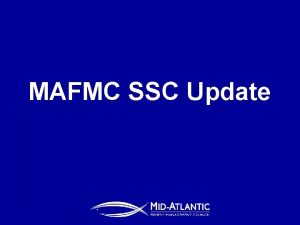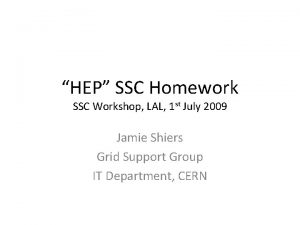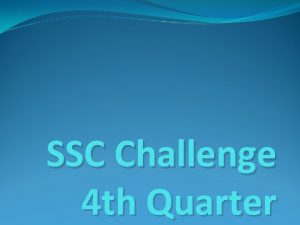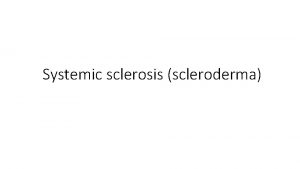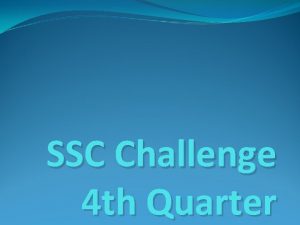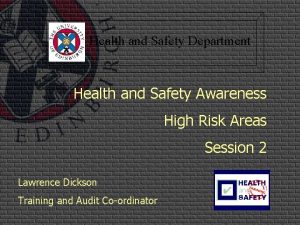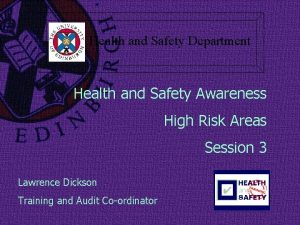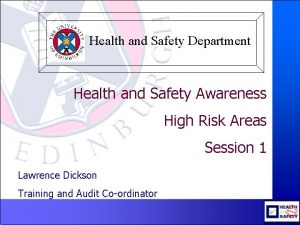HEALTH SAFETY AWARENESS SSC Societies Committee 2013 2014

















- Slides: 17

HEALTH & SAFETY AWARENESS SSC Societies Committee 2013 -2014

1. ASSESSING RISK 2

STEP 1. IDENTIFY THE HAZARDS A hazard is anything that may cause harm Consider what could go wrong: § How might people be injured or killed? § What happens in the event of an emergency § What is inherently risky as an element of this activity 3

STEP 2. IDENTIFY WHO MAY BE HARMED AND HOW THEY MAY BE HARMED Consider the people (in broad groups) who may be harmed by the activities § § Members of your society Special guests Members of the general public Others Consider how they may be harmed § What type of injury or harm is possible as a result of the activity 4

STEP 3. EVALUATE THE RISKS AND SET PRECAUTIONS Can risk be totally eliminated? If not, how can I mitigate the risk as much as reasonably practicable? § Try a less risky option § Prevent access/reduce exposure to the hazard § Be prepared for contingencies 5

STEP 4. RECORD AND IMPLEMENT YOUR FINDINGS Fill in our risk assessment form or submit one to socrisk@ and det 8@ You must show that you: § § § Made a proper check Considered who may be affected Dealt with all significant and foreseeable hazards The precautions are reasonable Your committee was properly appraised of their responsibilities 6

STEP 5. REVIEW AND AMEND IF REQUIRED Examine the risk assessment at regular intervals and amend it if circumstances change or the risks appear improperly mitigated Quarterly review is recommended 7

SAMPLE RISK ASSESSMENT: LECTURE IN UNIVERSITY VENUE Hazard Endangered Persons Overcrowding Event attendees Slips, trips, and falls Event attendees Mitigating Actions in Effect Tickets are issued to all events to ensure that venues do not exceed maximum fire capacity. Attendees are counted at the door. Events occur at university-maintained property; committee members ensure that no significant maintenance lapses exist before opening venues; committee members clean up spillages immediately using suitable methods and leave the floor dry. Mitigating Actions to be Implemented Good practices are currently being met to ensure that venue capacities are not exceeded. Committee members must be instructed in good practices for cleaning up spillages. Risk Unlikely/Major Possible/Minor 8

SAMPLE RISK ASSESSMENT: LECTURE IN UNIVERSITY VENUE Hazard Endangered Persons Travel injuries Guest lecturers Fire or natural disasters Event attendees Mitigating Actions in Effect Mitigating Actions to be Implemented Travel is booked only with train companies affiliated with National Rail that are believed to comply with all requirements of the Rail Safety and Standards Board or airlines which are believed to comply with all the requirements of the Civil Aviation Authority. Events occur at universitymaintained property; committee members are briefed on procedures for safe and expedient evacuation of premises; at events with a significant number of non-student attendees, all attendees are advised of the location of emergency exits. Good practices are currently being met to ensure that guest lecturers traveling to lectures are not injured or killed in the travel process. Unforeseeable/Catastrop hic Evacuation procedures for each venue must be reviewed with Committee members prior to events. Unforeseeable/Catastrop hic Risk 9

SAMPLE RISK ASSESSMENT: ALCOHOL LIABILITY MITIGATION POLICY Hazard Alcohol Poisoning Endangered Persons Attendees at social events Mitigating Actions in Effect Mitigating Actions to be Implemented Alcohol is only served at licensed pubs, bars, and restaurants; at any event where alcohol is served, the Vice President shall designate, in addition to any officers with operational responsibility at the event, two officers (including at least one executive officer) to abstain from consuming alcohol for the 12 -hour period preceding the projected start of the event and to remain sober for the duration of the event to monitor alcohol consumption and ensure the safety of attendees; upon knowledge and belief, licensed pubs, bars, and restaurants adhere to the legal requirement not to sell alcohol to intoxicated persons. Good practices are currently being met to ensure that attendees at social events do not suffer from alcohol poisoning. Risk Unlikely/Major 10

SAMPLE RISK ASSESSMENT: ALCOHOL LIABILITY MITIGATION POLICY Hazard Alcohol-Induced Anti-Social Behaviour Endangered Persons Attendees at social events Mitigating Actions in Effect Mitigating Actions to be Implemented Alcohol is only served at licensed pubs, bars, and restaurants; at any event where alcohol is served, the Vice President shall designate, in addition to any officers with operational responsibility at the event, two officers (including at least one executive officer) to abstain from consuming alcohol for the 12 -hour period preceding the projected start of the event and to remain sober for the duration of the event to monitor attendee behaviour and ensure the safety of attendees; upon knowledge and belief, licensed pubs, bars, and restaurants adhere to the legal requirement not to sell alcohol to intoxicated persons. Good practices are currently being met to ensure that attendees at social events do not suffer from alcohol poisoning. Risk Unforeseeable/Major 11

COMPOSITE RISK MATRIX Consequences Likelihood Insignificant Minor Moderate Major Catastrophic Foreseeable 5 10 15 20 25 Likely 4 8 12 16 20 Possible 3 6 9 12 15 Unlikely 2 4 6 8 10 Unforeseeable 1 2 3 4 5 1 -5: Officers may proceed 6 -9: Officers may proceed after advising Committee 10 -15: Officers shall not proceed without Committee consent 16 -25: Officers shall not proceed 12

2. HEALTH AND SAFETY REQUIREMENTS 13

RISK ASSESSMENTS Fill out a general risk assessment for all activities in the ordinary course of business § Foreseeable events within aims Fill out a supplementary risk assessment and event proposal for any event or activity outwith general risk assessment no later than 14 days prior to commencement 14

PRIVATE VEHICLES Submit an event proposal detailing the names of all drivers and vehicle registration numbers of all private vehicles for the trip Require the driver of every private vehicle to produce: a valid drivers license without endorsements Maintain copies of the above File a copy of the above with Risk Assessment Administrator no later than three working-days prior to the commencement of the trip (mailbox in General Office) 15

EVENTS IN PRIVATE RESIDENCES No society shall hold an event or activity in a private residence without leave of the Societies Committee a society may hold a meeting of its committee in a private residence, provided that the attendance of said meeting is limited to ten or fewer persons and does not include activities beyond the scope of a deliberative meeting. 16

3. QUESTIONS? 17
 Privacy awareness and hipaa awareness training cvs
Privacy awareness and hipaa awareness training cvs Cold storage
Cold storage Patient safety council malaysia
Patient safety council malaysia Kitchen safety awareness
Kitchen safety awareness Rf safety awareness training answers
Rf safety awareness training answers Crane swing radius barricade
Crane swing radius barricade Ammonia awareness safety policy
Ammonia awareness safety policy Back safety training
Back safety training Raising safety awareness
Raising safety awareness 2013 hospital national patient safety goals
2013 hospital national patient safety goals Formation of safety committee
Formation of safety committee Pa state inspection checklist form
Pa state inspection checklist form Pa safety committee certification
Pa safety committee certification Committee of public safety
Committee of public safety Committee of public safety
Committee of public safety Objective for mental health awareness
Objective for mental health awareness Mental health awareness poem
Mental health awareness poem Introduction to mental health awareness presentation
Introduction to mental health awareness presentation

